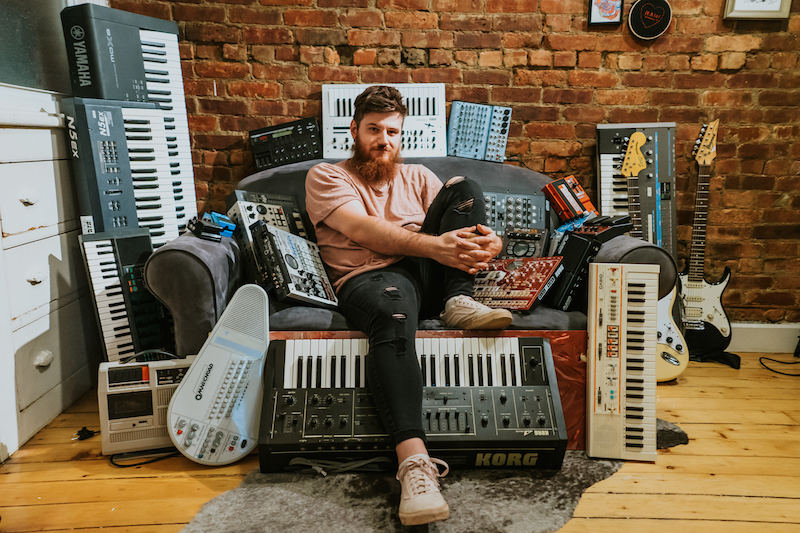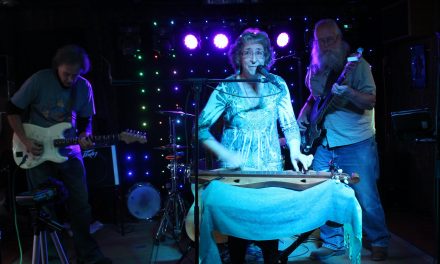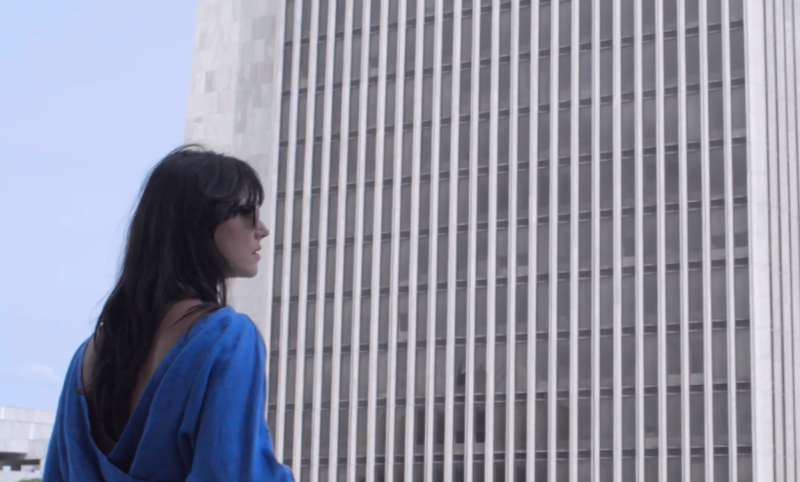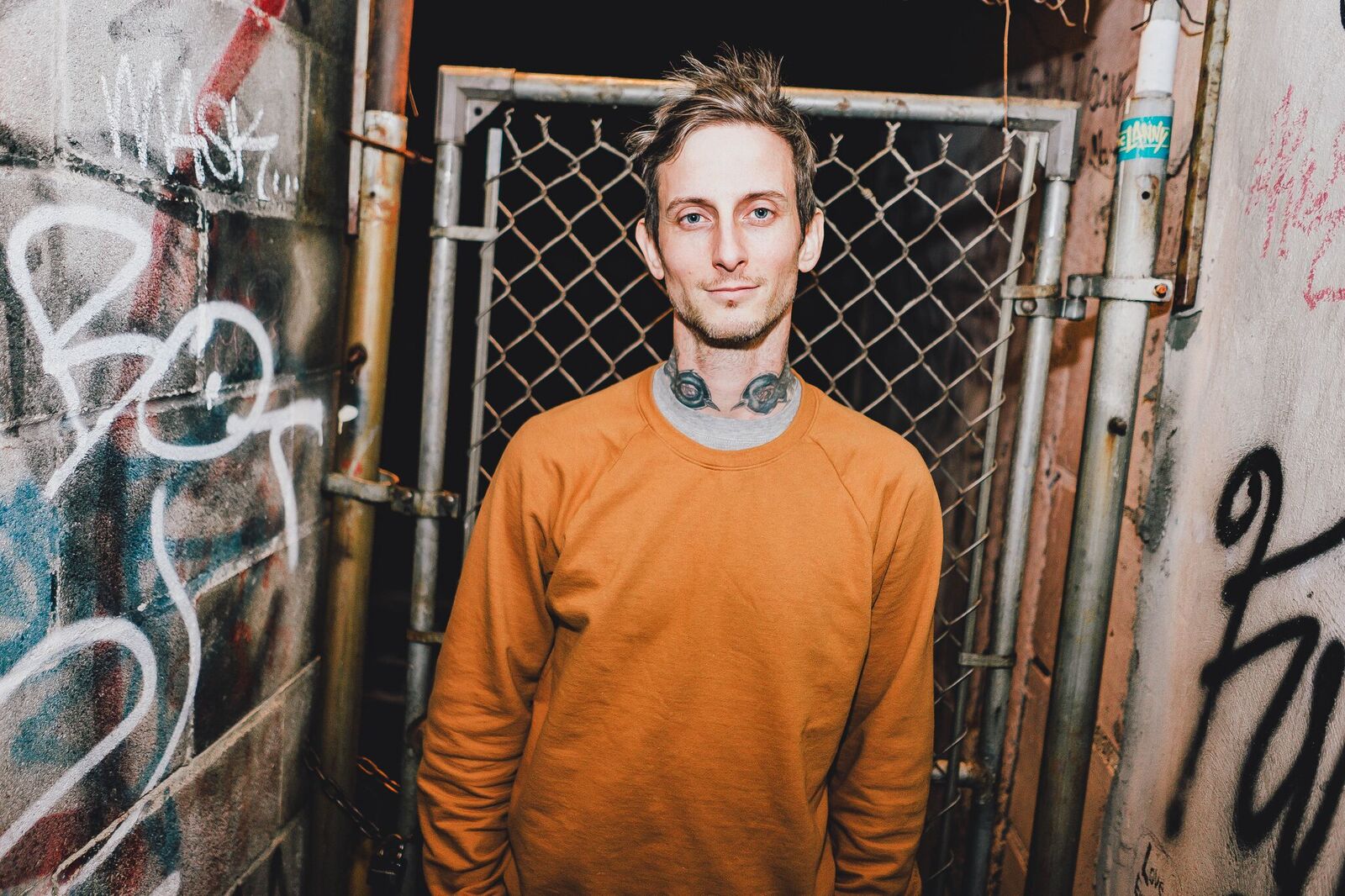This article first appeared in The Alt on November 8, 2017.
Photo by Kiki Vassilakis
Apostrophe S stands over his Korg Minilogue synthesizer keyboard in the darkness of RPI’s GZ Basement in Troy. Only his silhouette is lit by an open laptop, reflecting from his wire-rimmed glasses, and the dim glow of a cartoon (which appears to be a knock-off version of the Smurfs, if animated by Pepperland artist Heinz Edelmann) projected on the wall behind him. He is surrounded by wires and boxes covered in curious knobs and buttons and levels. It seems odd that one person could maneuver that amount of instrumental responsibility, but the artist at hand is stoic and pensive, tapping away to his own mechanical beats and as the moments pass, more heads in the audience start to nod, caught up in his spell.
“Electronic music is really tricky to do live but it’s kind of like magic in a certain sense,” says the artist. When it comes to making strange and unexpected sounds, he’ll be the one to do it.
The man behind the project, Dan Paoletti, has been composing music since he was 9 years old. Sitting at his desk at school, he used the lines of notebook paper to make staves, writing out notes on the fly.
“With no explicit purpose in mind,” he laughs. “I’ve always been drawn to the compositional frame of work. I’ve been writing songs and composing ever since.”
When he took up electronic music, he was 14, but nothing truly took off until he headed off to college. Since 2011, he has released over two dozen albums, not to mention his contributions to various compilations. Some have been written in a day, one took as long as three years.
Paoletti has now returned to college, in his senior year at St. Rose where he will earn a degree in music industry with a concentration in composition and songwriting. He composes classical pieces under his own name, while pursuing his electronic music projects under Apostrophe S and Confusician.
“I came up with an alter-ego thing which is silly, not befitting an artist of my small stature but whatever, it’s the internet age. You’re allowed to have as many secret personas as you want,” he shrugs.
While Apostrophe S is beat-oriented, Confusician tends to be the more experimental or open-ended persona whose style ventures into the subgenres of vaporwave and noise. It’s more “sound environment intensive”—best in a live performance environment, Paoletti says.
“I’ll write a piece and then run it through sampled instruments so it kind of sounds like it’s going through doinky, cheap ensemble of some kind that’s clearly computerized and I’ll work with that…There’s not a ton of people anymore that are like, ‘He’s not even playing anything.’ Now that we’ve gotten past that —hopefully—people are pretty easily astonished by the music [when] it’s panning really rapidly.”
Through his classical composition work, the artist has written for full orchestras and string quartets, once taking the opportunity to blend both spectrums of his musical talent into one.
“I wrote a piece for a string quartet and myself on live electronics, so I was manipulating the sounds of the string quartet coming in and amplifying what I was doing on the loudspeakers. It was a combined sound environment, which I performed in a recital class that we have. One person gave me a high-five at the end and was like, ‘You did something weird!’ Which is kind of alienating sometimes. I know that I spend all this time intentionally making stuff that I think is cool but sometimes it’s like, I didn’t mean for it to just be weird. That’s not what it’s supposed to be.”
Paoletti focuses on those moments of magic that happen during a set, when a sound he sends out connects with members of the audience in a way that never did for himself.
“It’s a fully improvised thing so I rely on people being easily amused because then I know where they’re at,” he says. “That’s what’s great about working in a computer environment, you can get at least a fair approximation of any instrument sound that you want, randomly. Part of the fun is learning how to make those sounds that come from different environments or aesthetic references get along with each other in a way that—hopefully—is interesting to other people.”
Mainly, Paoletti works out of Ableton Live, a digital audio workstation and music sequencing software. The program offers the artist a main stage, where he can work and mix straight from the keyboard. Or, he can jump off to outboard equipment if he’s inspired to mix and sample works without the challenge of limited programs.
When it comes to gear Paoletti has plenty, currently gathering a collection of late ‘90s, early 2000s samplers, effects processors and synthesizers he has found on Craigslist.
“I find them really fascinating because the processing that their chips can do is different that the Macbook Pro—that doesn’t do anything wrong,” Paoletti explains. “This equipment is slowly deteriorating, and it’s not like a guitar that sounds nicer the older it gets—if you take care of it—it breaks eventually. In the computer environment, you use a lot of plugins and pieces of software that do certain things and the more that I started getting into this analog, or early digital, gear, the more I realized that the plugins are designed to do what these things do, in a different way. So I wanted to go back and see what that equipment was like.”
He has a synthesizer from 1979, a sampler from 2002 and has become obsessed with tracking down the entire Roland SP series of samplers that he says each carry their own unique sound.
He has nabbed up a Korg product from each of the last five decades, including his latest: a Korg Kaoss Pad 3, which he uses most often live to add to the spontaneity of each performance.
“They’re these really neat effects processors that have a touchpad that processes two different parameters of an effect along an X-Y axis. So you can push really extreme either way, or for both, or you can compromise. It’s way nicer than a knob or two knobs and it gets all sorts of accidental cool sounds.”
The Kaoss Pad tags along with him for every set along with his Korg Minilogue keyboard accompaniment, where he’ll add in some samples on the fly. His Roland SP-404SX linear sampler connects with the Kaoss Pad for sampling and sequencing and everything routes through his his laptop, which runs the Ableton session as an effects control center and track listing. He can also change effects through his remote APC40 Ableton controller.
“I don’t understand how it all works necessarily,” he says nonchalantly, comparing the process to learning a new instrument. “Being able to have the technical technique with instruments is good with my application as well because I’ve never been happy just queuing up tracks and playing them, I’m very tactile.”
The improvisational direction in his sets is visceral. You can hardly keep up with his beats before he scoops it up, turns it on it’s head and sends it running along another plane. He is constantly exploring new diverting paths into the dark and looking for something new.
When it comes to absorbing sounds, the artist owns piles of CDs from Goodwill hunts that range in genre and sound, from new wave jazz to Disney star hits.
“That’s what keeps me engaged with the task of being a musician, to rejuvenate that curiosity,” he explains.
He raves about a compilation album he has loaded into his car that consists of Georgian three-part male harmonies. “This is the gold that I live for, it’s incredible,” he says. His search is usually focused on music that he never would have had the opportunity to explore, or would have even considered giving a try. It’s not always a jackpot find but he has some unexpected gems. He loves the wild craftsmanship of Bobby McFerrin’s Bang Zoom and recently acquired a bubbly Vanessa Hudgens album—which he loves for it’s first track, which starts with a 5-4 time signature, rare for a pop effort.
“I think it’s cool to sample some of that really pristine digital music—like loud pop music—because you don’t have to do a ton to it to make it sound really shitty all the sudden. It’s so on the cusp of falling apart, so as soon as you slow it down or turn it up, it starts to just completely disintegrate and it sounds really cool. A lot of unintended artifacts come to the surface.”
When it comes to sampling his library, Paoletti says it all happens on the fly. He’ll browse through his iTunes for a while until something resonates and he’ll explore. Sometimes it gets deleted after all but sometimes it’s the beginning of a new project.
“It just never stops. Some people like to run, some people like to work on business projects, some people like to paint. I just have to create stuff all the time. I think creative people just synthesize the world differently. Certain things resonate with your experiences stronger than others. The point is to try and synthesize that and spit it back out with your spin on it.”
Apostrophe S is one of quite a few electronic musicians in the local area, though you’ll have to do a bit of digging to find them. You can find some ambient, experimental, glitch and beat driven artists like Casual Decay and E.R. Yan in venues like the Experimental Media and Performing Arts Center (EMPAC) in Troy or supported by local DIY organizers like Paoletti.
“A lot of work needs to get done at this communal basement level and it’s thriving,” Paoletti says. “It’s inspired people to bring in new bands that are a little off kilter—compared to what you would have found in the area four or five years ago. It’s not a criticism of what has been here because those people are all still heavily involved in the scene.”
Artists also find support through the Albany Sonic Arts Collective, a grassroots organization dedicated to organizing sets and building a more diverse music scene, particularly in avant garde jazz, electronica, noise and free improvisation.
Though an organizer of mostly punk shows himself, Paoletti says the DIY scene has exposed more diverse and unique artists in recent years. To everyone’s benefit, there’s seems to be no distinct sound that defines the area—home to intermingling hip-hop, jazz, folk, indie and experimental scenes.
“Being in the genre that I am, it allows me to drift between not just those style shows,” he says. “I’ve done hip hop shows, I’ve done hardcore shows at the Low Beat, I’ve done these DIY shows, I’ll play a school with groups with more of a jazz or pop influence. I don’t want to be the only one though, I hope more people join me.”
You can find Apostrophe S and Confusician tunes on Bandcamp; Apostrophe S is also on Spotify.






Trackbacks/Pingbacks